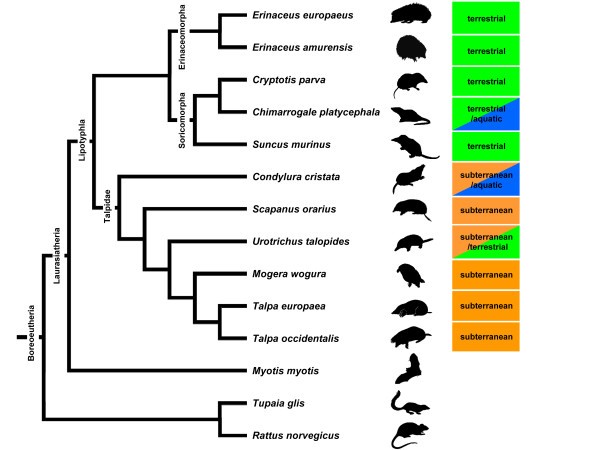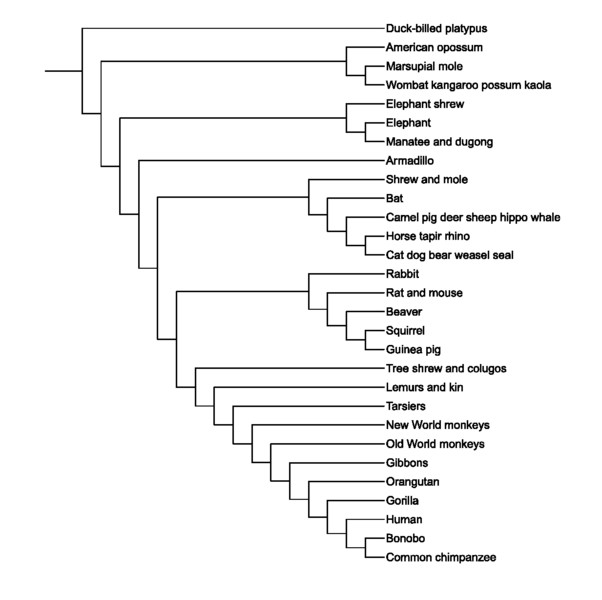Classification
Domain: Eukarya
Condylura cristata belongs to the Eukarya domain. This domain is
classified by organisms that are eukaryotic, or that have a
nucleus within their cells. In English, “eu” means true and
“kary” means nut, which refers to the nucleus inside (Borror
1960). So “Eukarya” means “True Nut”, or in other words, there
is a true nucleus holding DNA found within the cells.
Kingdom: Animalia
The next step on the tree for Condylura cristata is the kingdom
Animalia. This kingdom houses the animals of the world. Members of
the Animalia kingdom are multicellular and are heterotrophic,
meaning they need to consume other organisms for nutrients.
Phylum: Chordata
The Chordata phylum is a group of organisms that have formed a
notochord and dorsal nerve endings; “chorda” means chord. This
phylum includes deuterostomes, like Condylura cristata, that form
their anus before their mouth during development; “deuteron” means
second and “stoma” means mouth (Borror 1960). So this translates to
the mouth is second.
Class: Mammalia
The class Mammalia contains the mammals. These organisms are
vertebrates who feed their young with milk during their early years.
“Mammal” refers to the mammary glands that produce the milk (Borror
1960).
Order: Eulipotyphla
Eulipotyphla is the order that houses moles, shrews and hedgehogs,
all of which, are normally
insectivorous organisms. These animals must feed constantly to
store enough nutrients for their normally fast-moving lives. They
are normally pretty small, and can be found throughout the world,
with the only exception being extremely cold locations.
Family: Talpidae
Talp means “a mole” and, thus, Talpidae is the family of moles
(Borror 1960). A vast majority of these organisms are fossorial or
at least partially fossorial, meaning they live the majority of
their lives underground. Their eyes are usually extremely small and
usually useless. Most have powerful forelimbs that are built for
digging and foraging underground.
Genus: Condylura
The name for the genus Condylura was given based on an incorrect
drawing. “Condyl” means a knob or knuckle and “oura” is Greek for
the tail. So Condylura literally means a knob on the tail. Once
again, this was based on a bad drawing of a mole (Borror 1960).
Species: Condylura cristata
Condylura cristata is then named for its most obvious feature, its
star-shaped nose. “Crist” means a crest, which refers to the star on
its nose (Borror 1960). So Condylura cristata literally
means "Knob Tail Crest."

This figure shows the phlogenetic tree of the star-nosed mole and
its close relatives.
As you can see, Condylura crisata is a member of the family
Talpidae along with other moles. The Talpidae family is a subset of
the group Lipotyphla along with the Soricomorpha and the
Erinacemorpha famillies. Condylura cristata is the only
organism on this phylogeny that is both subterranean and also
aquatic.

This is the phylogeny of the class Mammalia. Condylura cristata
is found under shrews and moles. Even though you may expect
them to be closely related to rats and mice, they are actually more
closely related to animals such as dogs, cats, bats (like the
Pallid
Bat (Antrozous
pallidus)), rhinos and even whales (like the
Long-Finned Pilot
Whale (Globicephala
melas))!
